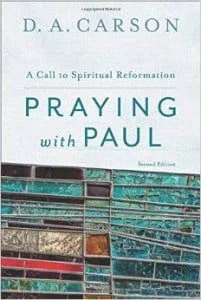⏱️ Estimated Reading Time: 5 min read
 Prayer is a vital practice in the life of Christian. So important in fact that the disciples asked Jesus directly to teach them how to pray (Luke 11:1). Scripture teaches that spiritual growth is cultivated as one grows in their prayer life. It is with this understanding that the reader approaches the prayers of the New Testament, particularly the Pauline prayers. Filled with theological detail, pastoral concern, and spiritual application Paul pours out his heart to the Lord on behalf of the recipients of his letters. In the second edition of Praying with Paul: A Call to Spiritual Reformation New Testament scholar Dr. D.A Carson explores such detail, concern, and application.
Prayer is a vital practice in the life of Christian. So important in fact that the disciples asked Jesus directly to teach them how to pray (Luke 11:1). Scripture teaches that spiritual growth is cultivated as one grows in their prayer life. It is with this understanding that the reader approaches the prayers of the New Testament, particularly the Pauline prayers. Filled with theological detail, pastoral concern, and spiritual application Paul pours out his heart to the Lord on behalf of the recipients of his letters. In the second edition of Praying with Paul: A Call to Spiritual Reformation New Testament scholar Dr. D.A Carson explores such detail, concern, and application.
The new edition of the book receives a new cover but has the same spiritually rich content that one expects from Dr. Carson. Though the book is not a comprehensive theology of prayer, the author aims to work through the Pauline prayers for the purpose of showing how the reader can begin to align their prayers with Scriptural priorities and grow through this process. Carson accomplishes this purpose with a combination of sound biblical exegesis, personal reflection, and pastoral wisdom. The content of the book is derived from a series of seven sermons preached by Carson which he explains in the preface and the extended note at the end of the work. Also each chapter has questions for review and reflection, which provides the reader an opportunity to apply the material.
Lessons from the School of Prayer: Spiritual Insight From Pauline Prayers
In chapter one, the author reflects on his own spiritual journey in which he states two sources have largely shaped his life: Scripture and mature Christians. As Carson begins the chapter he shares eight lessons he has learned from mature Christians in his life.
- Much praying is not done because we do not plan to pray.
- Adopt practical ways to impede mental drift.
- At various periods in your life, develop, if possible, a prayer-partner relationship.
- Choose models – but choose them well.
- Develop a system for your prayer lists.
- Mingle praise, confession, and intercession, but when you intercede, try to tie as many requests as possible to Scripture.
- If you are in any form of spiritual leadership, work at your public prayers.
- Pray until you pray.
Chapters two and three draws out implications from the rich theological framework of Paul’s prayer in 2 Thessalonians 1:3-12. Carson establishes the framework of Pauline prayers through two dominant features: Thankfulness for signs of grace and confidence in the prospect of vindication. The author then highlights these features as he explores Paul’s petitions in chapter three.
Chapter four is a stand only chapter that focuses on praying for others. In chapter five, the author establishes from 1 Thessalonians 3:9-13 a clear application of the need to pray for others.
In chapter six the author states, “The study of the Scriptures with a view to strengthen one’s prayer life has two foci. The first…the more we learn about God and his ways and his perspective, the more we improve our grasp not only of elemental theology but of prayer as well. The second…the study of the prayers of Scripture.” (76). Carson reflections upon these two foci as he works through Colossians 1:9-13.
All Christians have excuses for not praying. Chapter seven surveys the various excuses of busyness, spiritual dryness, lack of desire, bitterness, feeling ashamed, and being content with mediocrity. Carson takes up a few of these excuses in chapter eight where he outlines overcoming spiritual hurdles in Philippians 1:9-11.
Chapter nine sets forth two truths that must be acknowledged while praying. First, God is absolutely sovereign. Second, human beings are responsible creatures. These two truths are not in conflict but are taught in the Bible. Carson concludes, “We must do our best to ensure that these complementary truths function in our lives in the same ways they function in the lives of believers described in Scripture.”
In chapters ten and eleven Carson looks at Ephesians 1:15-23 and 3:14-21. In these chapters the author shows how praying to the sovereign God develops spiritual growth.
Lastly in chapter twelve Carson reflects pastorally upon Romans 15:14-33 showing how the reader can pray for those in the ministry.
Growing Spiritually Through Prayer
If one is looking for practical book on prayer that draws from brilliant exegetical insight Praying with Paul is a must read. As I read the book I was strengthened and challenged to cultivate deeper theological prayers as I seek to grow in my relationship with the Lord. I was personally struck by Carson’s encouragement to connect my prayers with Scripture. This reinforces the critical relationship between Scripture and prayer in the life of the Christian. I’m convinced that the discussion in chapter nine is of the upmost importance to read. If you should read one chapter, chapter nine on God’s sovereignty and man’s responsibility in prayer is it.
The principles discussed in the book allow the reader to see a truly God-centered approach to prayer as opposed to other popular works on prayer. On a practical note pastors could use the exegetical outlines of each text as a teaching tool. It could easily be adopted for a small group or one-on-one discipleship material. Make sure to pick up this book. Time will tell but I’m sure this will be a classic in years to come.
Buy this book Amazon.
I received this book for free from Baker Academic. I was not required to write a positive review. The opinions I have expressed are my own. I am disclosing this in accordance with the Federal Trade Commission’s 16 CFR, Part 255 : “Guides Concerning the Use of Endorsements and Testimonials in Advertising.




